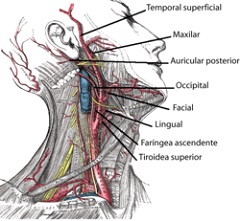Every time that I think I have heard it all when it comes to potential hair loss cures or partial solutions with some merit, something new and totally unexpected comes along. Recently, one of my blog readers “Peter” (who is also commenting in this post) sent me a link to the following interesting 1977 paper:
New Treatment for Seborrheic Alopecia: The Ligature of the Arteries of the Scalp
In essence, this doctor shut off (= ligature) two arteries near the face and scalp region. Lo and behold, balding slowed down in 76 percent of the 1,300 !!) patients on whom he performed this procedure (10 percent of whom were female). Moreover, 17 percent of patients saw regrowth in previously bald regions. The two arteries that were ligated were the temporal superficial artery and the posterior auricular artery.
The below image from wikipedia commons shows the location of those two arteries (first and third arrows from the top):

It should be noted that seborrheic alopecia is not exactly the same as androgenic alopecia. However, the above procedure should also work for androgenic alopecia as according to the article:
“If we accept that the main androgen hormone active on the skin target cells is dihydrotestosterone, a metabolite of circulating testosterone, then the enzymatic control of the alpha-reduction of testosterone into dihydrotestosterone is assumed by the 5-alpha-reductase. If this enzyme can be inhibited in the scalp, seborrheic alopecia will probably be reduced.
One of the most powerful non-toxic enzyme inhibitors is hypoxia. Through surgery, by ligature of the scalp arteries, hypoxia can be induced in the scalp (by reducing the speed of the normal blood flow through replacing the arterial flow by capillaries and by obtaining a diminished P02 in the ligated area). By creating hypoxia in the scalp, testosterone metabolism will be reduced and the condition improved.”
Note that “hypoxia” means oxygen deprivation. Besides a slowing down or reversal in balding, the conclusion of the article also states that sebum production in the study participants’ scalp was reduced. Subsequently, the condition of their hair follicles was strikingly improved. Including a reduction in dandruff, itching and greasiness.
For myself, the worst part of slowly losing hair over the past decade has been the associated scalp itching, dandruff and sebum. Dandruff shampoos have helped a lot in combating this problem, but some days are still annoying.
One interesting thing about this artery ligation procedure is that it reduces blood flow to the scalp. Over the years, I have read many expert and non-expert opinions that increased blood flow to the scalp can lead to better quality hair. However, it seems like normal blood flow is causing balding in susceptible individuals in the first place via supplying androgens to the scalp. So reduced blood flow can in fact help the hair. Who would have ever thought?!
Finally, I should mention that the reader who sent me the link to the above study from 1977 also sent me another link from a more recent slightly related study from 2014: cessation of hairline recession following open forehead rejuvenation. I do not think that this second study entails any type of artery ligature, but have not tried to find the full study.
I am guessing that this new procedure does nothing for crown region balding. The surgeon (Dr. Guyuron) who is the lead author of this second study has authored a detailed write-up on forehead rejuvenation.
Update: Also make sure check out this related interesting article on malocclusion and hair loss (in a dental setting).
NOTE: I would never ever go for such procedures and would advise readers to do the same. Very few doctors would have done something like this just for hair loss. The potential side effects are significant if the surgery is performed by an inexperienced person (and even experienced surgeons can have bad results). Moreover, there is no guarantee than your androgenic alopecia will be cured with such procedures.
Even a slowdown in the rate of balding is not guaranteed, based on the 76 percent success rate I discussed earlier. I would also like to find out how those of the 1,300 patients who are still alive feel about their procedure today. Did their hair loss restart after a few years Did they get any pain or necrosis in the long term? Was it okay to have a permanent reduction in scalp blood flow for decades?